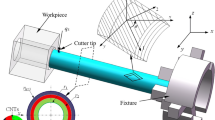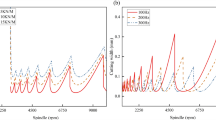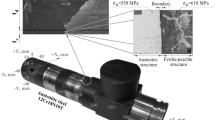Abstract
Compared with traditional linear models, the nonlinear model of boring can profoundly reveal the physical mechanism and mathematical laws of chatter occurrence, and has more rich scientific connotations. The nonlinear kinematic equations of the composite boring system containing carbon nanomaterials (CNMs) are derived by utilizing the energy method, which is taken to be the entry point for this paper. First of all, the basic mechanical parameters for the composite boring bar CNMs-embedded are derived based on the Halpin–Tsai Model (HTM) and the Rules of Mixture (ROM). From the perspective of continuous distribution, the mathematical expressions of kinetic and potential energy of the rotating boring bar are proposed by introducing the nonlinear strain. The specific and detailed nonlinear dynamic equations of the boring system are obtained using the extended Hamilton’s principle by considering the non-conservative virtual work consists of the nonlinear regenerative cutting and the damping force resulting from the viscoelastic and hysteretic damping of composite. Next, the nonlinear equations above are numerically decomposed and simplified using the general Galerkin method combined with modal expansion. The compact nonlinear equations are solved by the Multi-scale method and the primary and super-harmonic resonance solutions are obtained for the forward and backward modes, respectively. Then, the above nonlinear theoretical models are validated with published literature. Finally, the effects of CNMs, carbon fibers, cutting technological parameters on chatter amplitude as well as the unstable zone (curves) are investigated. The conclusions obtained confirm that the nonlinear theoretical model of the boring system proposed in present paper can effectively predict the complex relationships between various parameters within the boring system and provide theoretical guidance for the design of the composite cutter bar.






















Similar content being viewed by others
Data availability
The datasets generated during and/or analysed during the current study are available from the corresponding author on reasonable request.
References
Munoa, J., Beudaert, X., Dombovari, Z., Altintas, Y., Budak, E., Brecher, C., Stépán, G.: Chatter suppression techniques in the metal cutting. CIRP Ann. Manuf. Technol. 65(2), 785–808 (2016). https://doi.org/10.1016/j.cirp.2016.06.004
Zhu, L.D., Liu, C.F.: Recent progress of chatter prediction, detection and suppression in milling. Mech. Syst. Signal. Pr. 143(9), 106840-1–37 (2020). https://doi.org/10.1016/j.ymssp.2020.106840
Wang, W.K., Wan, M., Zhang, W.H., Yang, Y.: Chatter detection methods in the machining processes: a review. J. Manuf. Process. 77(5), 240–259 (2022). https://doi.org/10.1016/j.jmapro.2022.03.018
Lee, D.G., Suh, N.P.: Manufacturing and testing of chatter free boring bars. CIRP Ann. Manuf. Technol. 37(1), 365–368 (1988). https://doi.org/10.1016/S0007-8506(07)61655-2
Lee, D.G., Hwang, H.Y., Kim, J.K.: Design and manufacture of a carbon fiber epoxy rotating boring bar. Compos. Struct. 60(1), 115–124 (2003). https://doi.org/10.1016/S0263-8223(02)00287-8
Ghorbani, S., Rogov, V.A., Carluccio, A., Belov, P.S.: The effect of composite boring bars on vibration in machining process. Int. J. Adv. Manuf. Tech. 105, 1157–1174 (2019). https://doi.org/10.1007/s00170-019-04298-6
Thorenz, B., Friedrich, M., Westermann, H.H., Döpper, F.: Evaluation of the influence of different inner cores on the dynamic behavior of boring bars. Proc. CIRP 81, 1171–1176 (2019). https://doi.org/10.1016/j.procir.2019.03.287
Waydande, S., Mahajan, D.A., Gajjal, S.Y.: A review on vibration attenuation of boring bar using passive dampers. Int. J. Emerg. Technol. Adv. Eng. 4(4), 117–122 (2014). https://doi.org/10.15623/ijret.2015.0407020
Nagano, S., Koizumi, T., Fujii, T., Tsujiuchi, N., Ueda, H., Steel, K.: Development of a composite boring bar. Compos. Struct. 38(1–4), 531–539 (1997). https://doi.org/10.1016/s0263-8223(97)00089-5
Song, Q.H., Shi, J.H., Liu, Z.Q., Wan, Y., Xia, F.: Boring bar with constrained layer damper for improving process stability. Int. J. Adv. Manuf. Technol. 83(9–12), 1951–1966 (2016). https://doi.org/10.1007/s00170-015-7670-5
Liu, Y., Liu, Z.Q., Song, Q.H., Wang, B.: Development of constrained layer damping tool-holder to improve chatter stability in end milling. Int. J. Mech. Sci. 117(10), 299–308 (2016). https://doi.org/10.1016/j.ijmecsci.2016.09.003
Zhang, Y.H., Ren, Y.S., Tian, J.S., Ma, J.M.: Chatter stability of the constrained layer damping composite boring bar in cutting process. J. Vib. Control 25(16), 2204–2214 (2019). https://doi.org/10.1177/1077546319852240
Zhang, J.F., Wang, H., Ren, Y.S., Feng, C., Zhang, C.J.: Chatter and stability analysis of the slender composite boring bar with constrained damping Layer. Appl. Sci. 10(13), 1–19 (2020). https://doi.org/10.3390/app10134537
Yuvaraju, B.A.G., Nanda, B.K., Srinivas, J.: Investigation of stability in internal turning using a boring bar with a passive constrained layer damping. FME Trans. 49(2), 384–394 (2021). https://doi.org/10.5937/fme2102384Y
Wang, J., Wu, F.H., Han, Y.L., Sun, D.X.: Boring bar design with laminar composite structure and research on properties. Chin. Mech. Eng. 24(6), 711–715 (2013). https://doi.org/10.3969/j.issn.1004-132X.2013.06
Wang, J., Wang, J.C., Wu, F.H., Zhou, Y., Bai, H.: Research of visco-elastic damping anti-vibration grinding wheel spindle with composite structure. J. Mech. Eng. 50(15), 192–197 (2014). https://doi.org/10.3901/JME.2014.15.192
Ma, J.M., Ren, Y.S.: Free vibration and chatter stability of a rotating thin-walled composite bar. Adv. Mech. Eng. 10(9), 1–10 (2018). https://doi.org/10.1177/1687814018798265
Ma, J.M., Xu, J.F., Ren, Y.S.: Analysis on free vibration and stability of rotating composite milling bar with large aspect ratio. Appl. Sci. 10(10), 3557-1–17 (2020). https://doi.org/10.3390/app10103557
Ma, J.M., Xu, J.F., Li, L.F., Liu, X.G., Gao, M.: Analysis of cutting stability of a composite variable-section boring bar with a large length-to-diameter ratio considering internal damping. Mater. 15(15), 5465-1–22 (2022). https://doi.org/10.3390/ma15155465
Kim, W., Argento, A., Scott, R.A.: Forced vibration and dynamic stability of a rotating tapered composite timoshenko shaft: Bending motions in end-milling operations. J. Sound Vib. 246(4), 583–600 (2001). https://doi.org/10.1006/jsvi.2000.3521
Ren, Y.S., Zhang, Y.H.: Investigation of chatter stability of cutting process with a rotating tapered cutter bar considering internal and external damping. Int. J. Adv. Manuf. Tech. 107(3–4), 1755–1771 (2020). https://doi.org/10.1007/s00170-020-05049-8
Ren, Y.S., Zhang, Y.H., Zhang, J.F.: Analytical instability of milling with rotating tapered composite tool considering internal damping. Eng. Mech. (Online). https://doi.org/10.6052/j.issn.1000-4750.2022.02.0197
Zhang, Y.H., Ren, Y.S., Zhang, J.F.: Stability analysis of cutting process with internally damped rotating tapered composite cutter bar. Math. Probl. Eng. 2020, 1–23 (2020). https://doi.org/10.1155/2020/2587820
Zorzi, E.S., Nelson, H.D.: Finite element simulation of rotor bearing systems with internal damping. Trans. ASME J. Eng. Power 99, 71–76 (1977). https://doi.org/10.1115/1.3446254
Arumugam, A.B., Rajamohan, V., Bandaru, N., Edwin, S.P., Kumbhar, S.G.: Vibration analysis of a carbon nanotube reinforced uniform and tapered composite beams. Arch. Acoust. 44(2), 309–320 (2019). https://doi.org/10.24425/aoa.2019.128494
DeValve, C., Pitchumani, R.: Analysis of vibration damping in a rotating composite beam with embedded carbon nanotubes. Compos. Struct. 110(4), 289–296 (2014). https://doi.org/10.1016/j.compstruct.2013.12.007
Thomas, B., Roy, T.: Vibration and damping analysis of functionally graded carbon nanotubes reinforced hybrid composite shell structures. J. Vib. Control 23(11), 1711–1738 (2015). https://doi.org/10.1177/1077546315599680
Heydarpour, Y., Malekzadeh, P.: Dynamic stability of rotating FG-CNTRC cylindrical shells under combined static and periodic axial loads. Int. J. Struct. Stab. Dyn. 18(12), 1850151-1–29 (2018). https://doi.org/10.1142/s0219455418501511
Ansari, R., Torabi, J., Shakouri, A.H.: Vibration analysis of functionally graded carbon nanotube-reinforced composite elliptical plates using a numerical strategy. Aerosp. Sci. Technol. 60(1), 152–161 (2017). https://doi.org/10.1016/j.ast.2016.11.004
Alawy, A., Abdlghany, M., Zakaria Wafy, T., Hassan, A.: Effect of functionalized multi-wall carbon nanotubes/Biresin CR82 epoxy nanocomposite on vibration attenuation of aluminum plate. J. Vib. Control 27(15–16), 1910–1919 (2021). https://doi.org/10.1177/1077546320950518
Udatha, P., Sekhar, A.S., Velmurugan, R.: The effect of CNT to enhance the dynamic properties of hybrid composite tube shafts. Mech. Adv. Mater. Struct. 26(1), 88–92 (2019). https://doi.org/10.1080/15376494.2018.1534172
Hong, M.K., Choi, W.K., Park, J.H., Kuk, Y.S., Kim, B.S., Seo, M.K.: Relationship between functionalized MWCNT and damping properties of MWCNT/CFRP composites for shaft. J. Nanosci. Nanotechnol. 20(11), 6862–6870 (2020). https://doi.org/10.1166/jnn.2020.18810
Zhang, J.F., Tong, Z.F., Ren, Y.S., Feng, C., Cao, X.L., Zhong, P.S.: Dynamical stability analysis of rotating composite cutter bar with nanocarbon materials. Int. J. Struct. Stab. Dyn. 23(9), 2350102-1–30 (2023). https://doi.org/10.1142/S021945542350102X
Fu, Q.L., Lundin, D., Nicolescu, C.M.: Anti-vibration engineering in internal turning using a carbon nanocomposite damping coating produced by PECVD process. J. Mater. Eng. Perform. 23(2), 506–517 (2014). https://doi.org/10.1007/s11665-013-0781-y
Yuvaraju, B.A.G., Nanda, B.K., Srinivas, J.: Optimal cutting state predictions in internal turning operation with nano-SiC/GFRE composite layered boring tools. Int. J. Mach. Mach. Mater. 23(1), 1–20 (2021). https://doi.org/10.1504/IJMMM.2021.112714
Hanna, N.H., Tobias, S.A.: A theory of nonlinear regenerative chatter. J. Eng. Ind. 96(1), 247–255 (1974). https://doi.org/10.1115/1.3438305
Vela-Martínez, L., Jáuregui-Correa, C., González-Brambila, O.M., Herrera-Ruiz, G., Lozano-Guzmán, A.: Instability conditions due to structural nonlinearities in regenerative chatter. Nonlinear Dyn. 56(4), 415–427 (2009). https://doi.org/10.1007/s11071-008-9411-x
Deshpande, N., Fofana, M.S.: Nonlinear regenerative chatter in turning. Robot. Cim-Int. Manuf. 17(1–2), 107–112 (2001). https://doi.org/10.1016/s0736-5845(00)00043-0
Stépán, G., Insperger, T., Szalai, R.: Delay, parametric excitation, and the nonlinear dynamics of cutting processes. Int. J. Bifurcat. Chaos 15(9), 2783–2798 (2005). https://doi.org/10.1142/S0218127405013642
Moradi, H., Movahhedy, M.R., Vossoughi, G.: Bifurcation analysis of milling process with tool wear and process damping: regenerative chatter with primary resonance. Nonlinear Dyn. 70(1), 481–509 (2012). https://doi.org/10.1007/s11071-012-0470-7
Moradi, H., Vossoughi, G., Movahhedy, M.R., Ahmadian, M.T.: Forced vibration analysis of the milling process with structural nonlinearity, internal resonance, tool wear and process damping effects. Int. J. Non-Linear Mech. 54, 22–34 (2013). https://doi.org/10.1016/j.ijnonlinmec.2013.02.005
Jung, J., Ngo, C., Son, D., Seok, J.: Nonlinear modeling and dynamic simulation using bifurcation and stability analyses of regenerative chatter of ball-end milling process. Math. Probl. Eng. 2016, 4368680-1–16 (2016). https://doi.org/10.1155/2016/4368680
Jalili, M.M., Hesabi, J., Abootorabi, M.M.: Simulation of forced vibration in milling process considering gyroscopic moment and rotary inertia. Int. J. Adv. Manuf. Technol. 89(9–12), 2821–2836 (2017). https://doi.org/10.1007/s00170-016-9618-9
Mokhtari, A., Jalili, M.M., Mazidi, A.: Study on frequency response and bifurcation analyses under primary resonance conditions of micro-milling operations. Appl. Math. Model. 87, 404–429 (2020). https://doi.org/10.1016/j.apm.2020.06.016
Ma, B.L., Ren, Y.S.: Nonlinear dynamic analysis of the cutting process of a non-extensible composite boring bar. Shock. Vib. 2020(8), 5971540-1–13 (2020). https://doi.org/10.1155/2020/5971540
Yao, D.H., Ren, Y.S., Zhang, Y.H., Ma, B.L.: Nonlinear dynamics of cutting process considering higher-order deformation of composite cutting tool. Shock. Vib. 2021, 8699218-1–23 (2021). https://doi.org/10.1155/2021/8699218
Ren, Y.S., Yao, D.H.: Forced vibration in cutting process considering the nonlinear curvature and inertia of a rotating composite cutter bar. Math. Probl. Eng. 2020, 2463136-1–19 (2020). https://doi.org/10.1155/2020/2463136
Arab, S.B., Rodrigues, J.D., Bouaziz, S., Haddar, M.: Stability analysis of internally damped rotating composite shafts using a finite element formulation. CR Mecan 346(4), 291–307 (2018). https://doi.org/10.1016/j.crme.2018.01.002
Halpin, J.C.: Stiffiness and expansion estimates for oriental short fiber composites. J. Compos. Mater. 3(4), 732–734 (1969). https://doi.org/10.1177/002199836900300419
Melanson, J., Zu, J.W.: Free vibration and stability analysis of internally damped rotating shafts with general boundary conditions. J. Vib. Acoust. 120(3), 776–783 (1998). https://doi.org/10.1115/1.2893897
Rafiee, M.A., Rafiee, J., Wang, Z., Song, H.H., Yu, Z.Z., Koratkar, N.: Enhanced mechanical properties of nanocomposites at low graphene content. ACS Nano 3(12), 3884–3890 (2009). https://doi.org/10.1021/nn9010472
Ubaid, A.M., Dweiri, F.T., Ojiako, U.: Organizational excellence methodologies (OEMs): a systematic literature review. Int. J. Syst. Assur. Eng. Manag. 11(6), 1395–1432 (2020). https://doi.org/10.1007/s13198-020-01017-3
Gupta, V., Rathi, N.: Various objects detection using Bayesian theory. In: Proceedings of the International Conference on Computer Applications-Computer Applications-II. Research Publishing Services (2010). https://doi.org/10.3850/978-981-08-7304-2-1476
Arcos-Medina, G., Mauricio, D.: Aspects of software quality applied to the process of agile software development: a systematic literature review. Int. J. Syst. Assur. Eng. Manag. 10(5), 867–897 (2019). https://doi.org/10.1007/s13198-019-00840-7
Zhang, Z.P., Wang, Z.L.: Design of financial big data audit model based on artificial neural network. Int. J. Syst. Assur. Eng. Manag. (2021) (online). https://doi.org/10.1007/s13198-021-01258-w
Li, C.-W., Chao, Y.-Y.: The effect of auditing assurance levels on accounting conservatism: evidence from Taiwan. Int. J. Syst. Assur. Eng. Manag. 11(1), 64–76 (2020). https://doi.org/10.1007/s13198-019-00925-3
Alrae, R., Nasir, Q., Talib, M.A.: Developing house of information quality framework for IoT systems. Int. J. Syst. Assur. Eng. Manag. 11(6), 1294–1313 (2020). https://doi.org/10.1007/s13198-020-00989-6
Gupta, V., Mittal, M., Mittal, V.: FrWT-PPCA-based r-peak detection for improved management of healthcare system. IETE J. Res. (2021). (online). https://doi.org/10.1080/03772063.2021.1982412
Gupta, V., Mittal, M., Mittal, V.: A novel FrWT based arrhythmia detection in ECG signal using YWARA and PCA. Wirel. Pers. Commun. 124(2), 1229–1246 (2022). https://doi.org/10.1007/s11277-021-09403-1
Gupta, V., Saxena, N.K., Kanungo, A., Kumar, P., Diwania, S.: PCA as an effective tool for the detection of r-peaks in an ECG signal processing. Int. J. Syst. Assur. Eng. Manag. 13(5), 2391–2403 (2022). https://doi.org/10.1007/s13198-022-01650-0
Gupta, V., Mittal, M., Mittal, V., Chaturvedi, Y.: Detection of r-peaks using fractional Fourier transform and principal component analysis. J. Ambient Intell. Hum. Comput. 13(2), 961–972 (2022). https://doi.org/10.1007/s12652-021-03484-3
Gupta, V., Mittal, M., Mittal, V., Saxena, N.K., Chaturvedi, Y.: Nonlinear technique-based ECG signal analysis for improved healthcare systems. In: Algorithms for Intelligent Systems, pp. 247–255. Springer, Singapore (2021). https://doi.org/10.1007/978-981-16-3246-4_20
Gupta, V., Mittal, M., Mittal, V.: A simplistic and novel technique for ECG signal pre-processing. IETE J. Res. (2022). https://doi.org/10.1080/03772063.2022.2135622
Gupta, V.: Application of chaos theory for arrhythmia detection in pathological databases. Int. J. Med. Eng. Inform. 15(2), 191 (2023). https://doi.org/10.1504/IJMEI.2023.129353
Gupta, V., Mittal, M., Mittal, V., Saxena, N.K.: Spectrogram as an emerging tool in ECG signal processing. In: Recent Advances in Manufacturing, Automation, Design and Energy Technologies, pp. 407–414. Springer, Singapore (2021). https://doi.org/10.1007/978-981-16-4222-7_47
Gupta, V., Mittal, M., Mittal, V., Diwania, S., Saxena, N.K.: ECG signal analysis based on the spectrogram and spider monkey optimisation technique. J. Inst. Eng. (India) Ser. B 104(1), 153–164 (2023). https://doi.org/10.1007/s40031-022-00831-6
Gupta, V., Mittal, M., Mittal, V., Gupta, A.: An efficient AR modelling-based electrocardiogram signal analysis for health informatics. Int. J. Med. Eng. Inform. 14(1), 74–89 (2022). https://doi.org/10.1504/IJMEI.2022.119314
Gupta, V.: Wavelet transform and vector machines as emerging tools for computational medicine. J. Ambient Intell. Hum. Comput. 14(4), 4595–4605 (2023). https://doi.org/10.1007/s12652-023-04582-0
Acknowledgements
This work was financially supported by the National Natural Science Foundation of China (Grant No. 11672166) and the Natural Science Foundation of Shandong Province (Grant no. ZR202103070107).
Funding
The funding was provided by the National Natural Science Foundation of China (Grant No. 11672166) and the Natural Science Foundation of Shandong Province (Grant No. ZR202103070107).
Author information
Authors and Affiliations
Corresponding authors
Ethics declarations
Conflict of interest
The authors declare that they have no conflict of interest.
Additional information
Publisher's Note
Springer Nature remains neutral with regard to jurisdictional claims in published maps and institutional affiliations.
Rights and permissions
Springer Nature or its licensor (e.g. a society or other partner) holds exclusive rights to this article under a publishing agreement with the author(s) or other rightsholder(s); author self-archiving of the accepted manuscript version of this article is solely governed by the terms of such publishing agreement and applicable law.
About this article
Cite this article
Zhang, J., Jia, J., Feng, C. et al. Investigation of chatter suppression by using rotating composite boring bar CNT-filled based on a modified nonlinear dynamical model. Nonlinear Dyn 111, 20735–20770 (2023). https://doi.org/10.1007/s11071-023-08986-7
Received:
Accepted:
Published:
Issue Date:
DOI: https://doi.org/10.1007/s11071-023-08986-7




